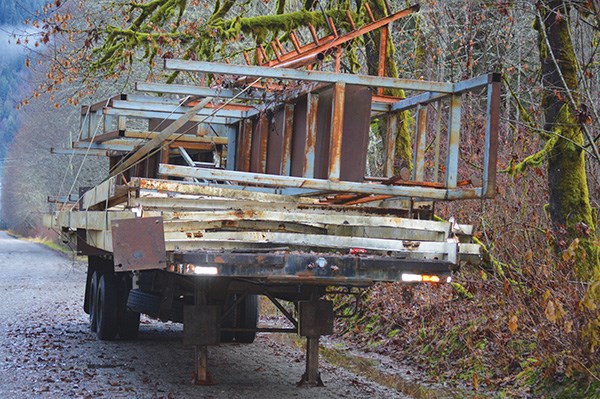Someone is dumping old building material and other inappropriate items on sites in the Upper Squamish Valley.
In some locations, dump trucks are coming to the area on a regular basis from the Lower Mainland, according to residents of the area.
The situation has reached the point where the Squamish-Lillooet Regional District is devising a bylaw to deal with the dumping.
While some material might be proper fill used to shore up low-lying property in the flood plain, there are other cases of old building scraps and other material being deposited
“You’d at least expect it to look like soil,” said Area D director Tony Rainbow. “It’s demolition debris, is what it is.”
Residents contacted Rainbow about the dumping and sent photos of trucks in action, in particular of a site in the Magee Road area where shattered planks and old slabs of concrete were dumped.
When Rainbow became director last year, he heard from residents immediately about the dumping. “This was the first issue they raised,” he said.
Some believe the material is coming from construction sites in the Vancouver area, and local landowners in the Upper Squamish are charging trucks to dump on properties.
Another concern is that the sites in question are included in the province’s Agricultural Land Reserve.
Colin Fry, Agricultural Land Commission (ALC) chief tribunal officer, could not speak to specific cases in the Squamish area but did confirm the land commission has looked at sites in the region over dumping of inappropriate materials.
“One of the officers has been up into that area a couple of times in recent past, and there are some ongoing issues,” he said, adding, “It’s not geographically confined, it’s pretty widespread.”
Fry said the business of dumping can be lucrative, both for landowners and construction businesses looking for a place to get rid of old materials.
Complicating the issue are concerns about old drywall and whether it is contaminated by hazardous material such as asbestos.
At present, the ALC can impose penalties of up to $100,000, although Fry said not every inquiry results in a stop-work order.
“For the most part, people are generally cooperative,” he said.
The preferred option is to get people to comply with regulations and take responsibility for cleanup of the sites, which depending on the amount of material could be as costly as any penalty.
For its part, the Squamish-Lillooet Regional District is developing the new bylaw to cover soil deposit and removal, which would give staff the authority to issue tickets and fines or take court action.
The bylaw describes the Upper Squamish Valley as a “hot spot” for the activity because of its proximity to the Vancouver area, as well as the lack of regulations when compared with other neighbouring municipalities or regional districts. Among the materials cited in complaints are construction garbage, wood waste, concrete and asphalt.
Rainbow said the regional district and residents are united in wanting something done to put a stop to the practice, and he hopes the regional district bylaw will help.
“We’ll have some more power to do something,” he said, adding, “Even with our bylaw in place, we won’t have anything like the ALC.”



